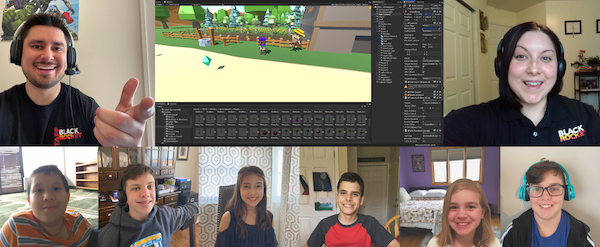
When I was a teacher, I had the pleasure of attending a speaking session with Harry Wong, author of The First Days of School. He opened that session by asking everyone who was a parent to raise their hands. He followed with,”Congratulations, you have the hardest job in the world.” He then said that we would soon also have the second hardest job in the world as educators. As home-educators, we have taken the two most challenging professions and combined them into a single entity. With the addition of teaching virtually and with technology, that challenge has doubled again.
When the pandemic first hit, my family was quickly forced to transition to a remote curriculum. I rapidly learned that the materials sent home from my school were insufficient to meet the needs of my children. I scrambled to find materials and learning options and opportunities for my children.
Fast forward several months, we are still in a state of semi-quarantine and our children will not be returning to school. My family has opted to keep our children home and home-school them. With the summer under our belts, we have learned a great deal about educating children at home.
This summer, my other family, Black Rocket Productions, had the pleasure of serving approximately 11,000 students from nearly all 50 states and several countries, including Peru, Spain, Germany, India, Saudi Arabia, and South Korea. Our team has worked with students for almost 20 years, designing enrichment technology programs, including App Development, Coding, 2D and 3D Game Design, Video Recording and Editing, 3D Modeling and much more. While many of our programs did not meet the criteria for online learning, such as robotics, drones, and stop animation, we were able to transition many of our programs to online.
As we progressed through the summer, we had many takeaways and learned a great deal about teaching and learning from home, particularly in relation to technology.
1. Test Everything - Before you begin, and not just the morning before, but the week or at least the weekend before, make sure you have all software downloaded and installed. Will you be attending a webinar or group conference with your children? Does your camera and microphone work? Can your internet handle the extra bandwidth of a live video feed?
2. Learning Online IS Frustrating and Challenging - Let your children struggle and make mistakes. This is the best way to learn. Authors such as Carol Dweck and Angela Duckworth speak about growth mindset and grit. As a parent and an educator, I want to help my children by providing them with scaffolding to support them in their learning. However, it is also important to let children toil through a problem in order to overcome it. The results will be worth it. Not only will your children learn the desired learning objectives, but they will gain the lifelong skills of problem solving, patience, and perseverance, key requirements for creating successful adults. Watching them struggle will be hard, but the long-term results will greatly outweigh the short-term benefits of getting through the content quickly or consoling an upset child..
3. Chunk the Time - Sitting in front of a computer for hours a day can be challenging for anyone, especially young children. Remember to take frequent breaks, both for the body and mind. Find a physical activity children can do either near their workspace, or on the screen, such as a short exercise video for movement or stretching. My children love GoNoodle!
The same is true for learning activities. As a teacher I followed a workshop model of a 5-7 minutes of whole group, direct instruction. I then gave children opportunities to brainstorm, share and collaborate with their peers. This activity is essential to the design and creative process, regardless of the subject matter. From there, children would work on their activity for the next 20 minutes or so, primarily independently. I would frequently check in with them through “Status of the Class” and mini-conferences. This model has proven highly effective in the online learning environment.
4. Communication and Collaboration are Essential - Whether children are learning at home, online, or in the classroom, an important part of learning is processing and communicating their ideas. Talking through ideas and brainstorming provides children with an opportunity to plan and practice. It also allows children the opportunity to socialize and practice giving and receiving feedback with peers. Instructor conferencing and peer interactions further allow the brain time to process and analyze thoughts and ideas before and after skills are taught and practiced, leading to greater mastery and less social isolation. We often achieved this goal by breaking children up into small groups of 8-10 children, which we called breakout sessions. Each session was led by an instructor and provided children with time to conference, practice, share projects, and socialize.
5. Teach Skills, Not Content - When working with technology it is essential to allow children freedom and creativity. When we focus our instruction around content children often do not understand how to apply and transfer those ideas to other problems. At Black Rocket we believe that by teaching children skills related to technology, those skills become transferable to other aspects of learning and life. While many children are excellent at navigating to a favorite app or website on a computer, they have very little understanding of file directories, paths, and how programs interact with each other. The same is true when it comes to playing vs. developing video games.
6. Make it FUN! - Our children should be Safe, Having Fun, and Learning, in that order. You cannot learn if you do not feel safe, and you learn best when you are having fun. Identify your child’s interests and tailor their learning experiences around those interests. When working with students, I found that many children were drawn to video games like Minecraft and Roblox. I used those interests to develop lessons around Mathematics, Science, Social Studies, and Language Arts. We found opportunities to integrate storytelling, core mathematical principles, and history into the worlds that we created. Long after the lesson ended, children continued to research, design, create and seek additional learning opportunities due to their interest and investment in the project..
Online learning can be a challenge for many reasons. Unfamiliarity with software and technology, feelings of isolation and loneliness, a lack of authenticity and meaning, or simply the challenge of sitting still for extended periods of time can stifle learning. Once instructors began to master these six skills we saw a dramatic increase in student engagement. In just15-hours of instruction, many students formed a lifelong love of learning for their topic and forged new friendships. By giving our students the time and tools to create, we empowered a new generation of learners through online and virtual learning.

Mark Grundel is the Director of Operations for Black Rocket Productions. Prior to working with Black Rocket, Mark was an elementary educator for a Title 1 School District in South Jersey. He was recognized as his district's Teach of the Year in 2016. Mark has done consulting and training for Microsoft and its affiliates on game-based learning with a focus on Minecraft in education.
Mark has two young boys who are currently being homeschooled using a blend of traditional and 21st Century learning strategies. Online course offerings, curriculum, and other resources may be found at Blackrocket.com/online.





